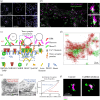Activity-dependent diffusion trapping of AMPA receptors as a key step for expression of early LTP
- PMID: 38853553
- PMCID: PMC11343219
- DOI: 10.1098/rstb.2023.0220
Activity-dependent diffusion trapping of AMPA receptors as a key step for expression of early LTP
Abstract
This review focuses on the activity-dependent diffusion trapping of α-amino-3-hydroxy-5-methyl-4-isoxazolepropionic acid receptors (AMPARs) as a crucial mechanism for the expression of early long-term potentiation (LTP), a process central to learning and memory. Despite decades of research, the precise mechanisms by which LTP induction leads to an increase in AMPAR responses at synapses have been elusive. We review the different hypotheses that have been put forward to explain the increased AMPAR responsiveness during LTP. We discuss the dynamic nature of AMPAR complexes, including their constant turnover and activity-dependent modifications that affect their synaptic accumulation. We highlight a hypothesis suggesting that AMPARs are diffusively trapped at synapses through activity-dependent interactions with protein-based binding slots in the post-synaptic density (PSD), offering a potential explanation for the increased synaptic strength during LTP. Furthermore, we outline the challenges still to be addressed before we fully understand the functional roles and molecular mechanisms of AMPAR dynamic nanoscale organization in LTP. This article is part of a discussion meeting issue 'Long-term potentiation: 50 years on'.
Keywords: AMPAR diffusion trapping; AMPAR trafficking; long-term potentiation; synaptic plasticity.
Conflict of interest statement
We declare we have no competing interests.
Figures



Similar articles
-
Hippocampal LTP and contextual learning require surface diffusion of AMPA receptors.Nature. 2017 Sep 21;549(7672):384-388. doi: 10.1038/nature23658. Epub 2017 Sep 13. Nature. 2017. PMID: 28902836 Free PMC article.
-
Postsynaptic density 95 controls AMPA receptor incorporation during long-term potentiation and experience-driven synaptic plasticity.J Neurosci. 2004 Jan 28;24(4):916-27. doi: 10.1523/JNEUROSCI.4733-03.2004. J Neurosci. 2004. PMID: 14749436 Free PMC article.
-
Regulation of AMPA receptor surface diffusion by PSD-95 slots.Curr Opin Neurobiol. 2012 Jun;22(3):453-60. doi: 10.1016/j.conb.2011.10.010. Epub 2011 Nov 1. Curr Opin Neurobiol. 2012. PMID: 22051694 Review.
-
The role of AMPAR lateral diffusion in memory.Semin Cell Dev Biol. 2022 May;125:76-83. doi: 10.1016/j.semcdb.2022.01.009. Epub 2022 Feb 3. Semin Cell Dev Biol. 2022. PMID: 35123863 Review.
-
Control of Homeostatic Synaptic Plasticity by AKAP-Anchored Kinase and Phosphatase Regulation of Ca2+-Permeable AMPA Receptors.J Neurosci. 2018 Mar 14;38(11):2863-2876. doi: 10.1523/JNEUROSCI.2362-17.2018. Epub 2018 Feb 13. J Neurosci. 2018. PMID: 29440558 Free PMC article.
Cited by
-
AMPA receptor diffusional trapping machinery as an early therapeutic target in neurodegenerative and neuropsychiatric disorders.Transl Neurodegener. 2025 Feb 11;14(1):8. doi: 10.1186/s40035-025-00470-z. Transl Neurodegener. 2025. PMID: 39934896 Free PMC article. Review.
-
Long-term potentiation: 50 years on: past, present and future.Philos Trans R Soc Lond B Biol Sci. 2024 Jul 29;379(1906):20230218. doi: 10.1098/rstb.2023.0218. Epub 2024 Jun 10. Philos Trans R Soc Lond B Biol Sci. 2024. PMID: 38853569 Free PMC article.
-
Exploring the role of ubiquitination modifications in migraine headaches.Front Immunol. 2025 Jan 31;16:1534389. doi: 10.3389/fimmu.2025.1534389. eCollection 2025. Front Immunol. 2025. PMID: 39958329 Free PMC article. Review.
References
Publication types
MeSH terms
Substances
Grants and funding
LinkOut - more resources
Full Text Sources

